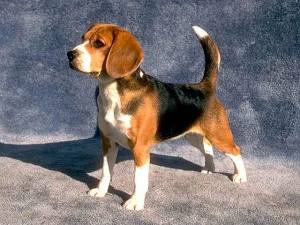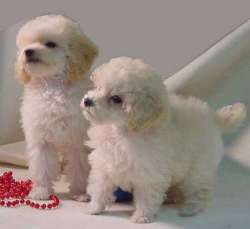 Beagles are a brilliant family companion dog breed. They have a wonderful gentle nature, a real zest for life and are happy, affectionate characters. They are the type of dog who the entire family can form a very special and close bond with.
Beagles are a brilliant family companion dog breed. They have a wonderful gentle nature, a real zest for life and are happy, affectionate characters. They are the type of dog who the entire family can form a very special and close bond with.
Beagles have a lovely soft expression about them, with their big floppy ears and intelligent dark eyes. It’s hard not to fall in love with them!
Beagle puppies have boundless energy and more than their share of intelligence – although Beagle puppy training is not without its challenges. You can read more about specific Beagle training tips including Beagle potty training and crate training your Beagle further down this page.
Beagle Dog Breed History
Beagles are one of the most popular of all dog breeds around the world today – they are also one of the oldest of the purebred hounds.
Beagle ancestry dates back to about 200AD in various parts of Europe. The breed grew in prominence and were developed further, much later on in Great Britain. Beagles became highly sought after for their outstanding hunting abilities – they were most commonly used as scent hounds for tracking small game.
Even today, although rare it is a magnificent sight to see a field full of Beagles, noses to the ground working a scent, with their white tipped tails wagging high above them.
Beagle Appearance
Beagles are considered a medium size dog breed. They have a long muscular body and possess great athleticism and loads of stamina. Beagle puppies are usually born black and white with the other colors coming through over the first few months. Tri color Beagles are the most common variety but any combination of hound colors is fine. They have an attractive shiny coat which is thick, of medium length and weatherproof – they do shed!
Beagles are typically 13-16 inches tall at the shoulder and weigh in at around 25-30 pounds. You may occasionally see Beagle breeders advertising “Miniature Beagles” or “Teacup Beagles For Sale” – this is just a smaller version of the same lovely breed.
Beagle Temperament
Along with the Beagles obvious good looks it is their lovely gentle temperament that wins over dog lovers worldwide.
At their best when they have been well bred, socialized and trained Beagles have a beautiful even temperament and merry disposition. Beagle owners also know them to be cheeky, mischievous but above all, friendly. They are great with children (love to play games!) and get along well with other pets.
Beagles actually crave human company. They hate to be separated from their “human pack” for long periods. Beagles who are left alone and frustrated each day often suffer from separation anxiety which can lead to various destructive behaviors (digging, barking and even self mutilation). If you and your family are required to be away from home for hours and hours on end then a Beagle puppy is probably not for you.
If you are planning to bring a Beagle puppy into your household be sure that you have sufficient fencing around your property. Not having a secure area for your Beagle is a recipe for disaster. They are notorious for roaming when given half a chance and unfortunately it often ends badly…
You’ll find your Beagle to be ever alert, inquisitive, and of course have an acute sense of smell. They do make good watchdogs, with their distinctive deep bark enough to raise the alarm. They are not what you would call good guard dogs though – they are far too friendly!
Even though Beagles are not considered to be an aggressive breed they can be prone to food guarding. You can read an article about this here – canine possession aggression (Beagle puppy training certainly helps to prevent this and many other potential behavior problems).
Beagle Health Concerns
The Beagle dog breed is generally a hardy specimen with a healthy constitution. They typically live an active 12-15 years. As with all dog breeds they do have a few health problems which can worry them.
NOTE: Purchasing your puppy from a reputable Beagle breeder gives you the best chance of bringing a well balanced, physically and mentally sound dog into your life. This can save you and your family much heartache in the future. Your Beagle breeder also has the crucial task of beginning the puppy socialization process.Your Veterinarian and Beagle breeder can offer you more specialized Beagle health care advice, but you should at least be aware of some of the potential health problems listed below.
- The long floppy ears of your Beagle can present a few problems. The shape of the ears means that they are susceptible to a build up of yeast and other infections. Management is the key to preventing this problem. Regular inspection of the ear every couple of days is required and a clean out when necessary.
- Beagles love their food! This is a good thing really but you must feed the right food in the right amount to avoid obesity – don’t rely on your Beagle to tell you when he/she is hungry! Your Beagle breeder will give you a good feeding plan – try to stick with it. Overweight Beagles are much more likely to suffer from a wide range of serious health problems.
- Beagles are one of the breeds most likely to suffer from canine epilepsy. This is usually an inherited condition which results in repeated seizures. Your Veterinarian can help with a suitable treatment.
- Like most dog breeds the Beagle does suffer from some skin conditions and also arthritis when they get older.
Beagle Puppy Training – And Older Beagles!
You and your Beagle will forge a strong mutual bond throughout the training process.Beagles don’t lack anything in intelligence but can be a little stubborn during training sessions. Some people say that they have a mind of their own.For this reason it is important to get straight into your Beagle puppy training as early as possible. Doing so will ensure that your Beagle puppy establishes good habits right from the start and will prevent many undesirable behaviors from ever developing.Beagles respond best to positive, non violent training methods which are based on consistency, repetition and rewards (food is a great motivator to Beagles!). There is no place or reason for harsh “old school” training techniques which rely on intimidation and punishment.You’ll find your Beagle puppy to be a capable, enthusiastic training partner and also a quick learner. All the basic obedience training commands such as sit, down, stay, fetch, heel and many more are easily mastered by Beagle puppies.There are a few specific training issues that Beagle owners need to pay close attention to:
- Many people get frustrated with the Beagle Potty Training Process. It doesn’t need to be such a big problem. Most Beagle breeders recommend crate training during the puppy house training period. This method relies on sticking to a proven schedule, confinement and supervision. You can find a great Beagle potty training plan in this – comprehensive Beagle training course.
- Another Beagle training issue which needs to be addressed is to train your Beagle to walk nicely on a loose leash. Beagles are strong and will pull very hard on the leash if allowed to get away with it. They get their nose down to the ground and just go go go with no regard to what they are pulling along behind them! Hopefully you and your Beagle will be spending a lot of time out and about enjoying a walk so it’s a good behavior to work on.
- Beagles can never be fully trusted off leash. If your Beagle is off lead they are often easily distracted and can wander off on a scent trail. For situations like this you will need to call on the obedience training “come command” (sometimes called recall). This command should be taught early and practiced regularly – it may even save your Beagles life one day.







